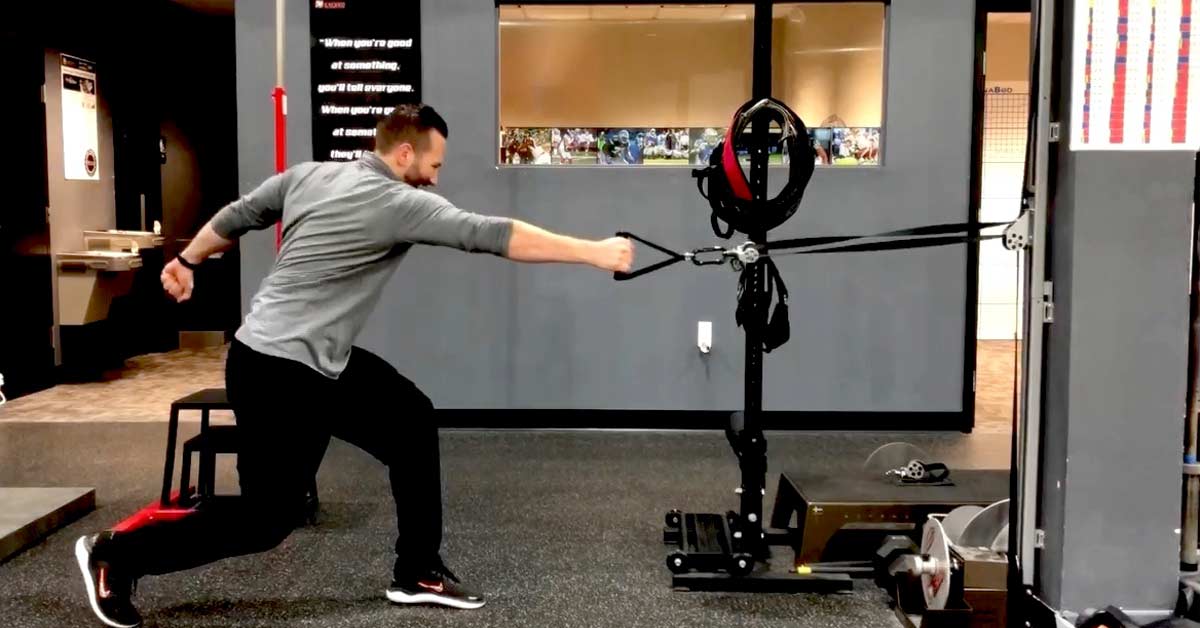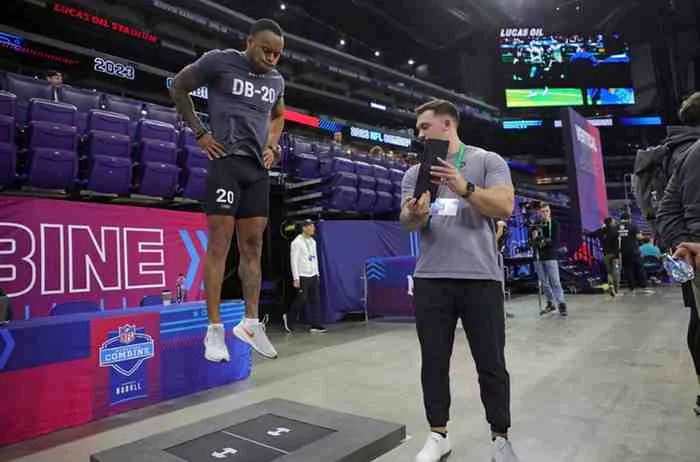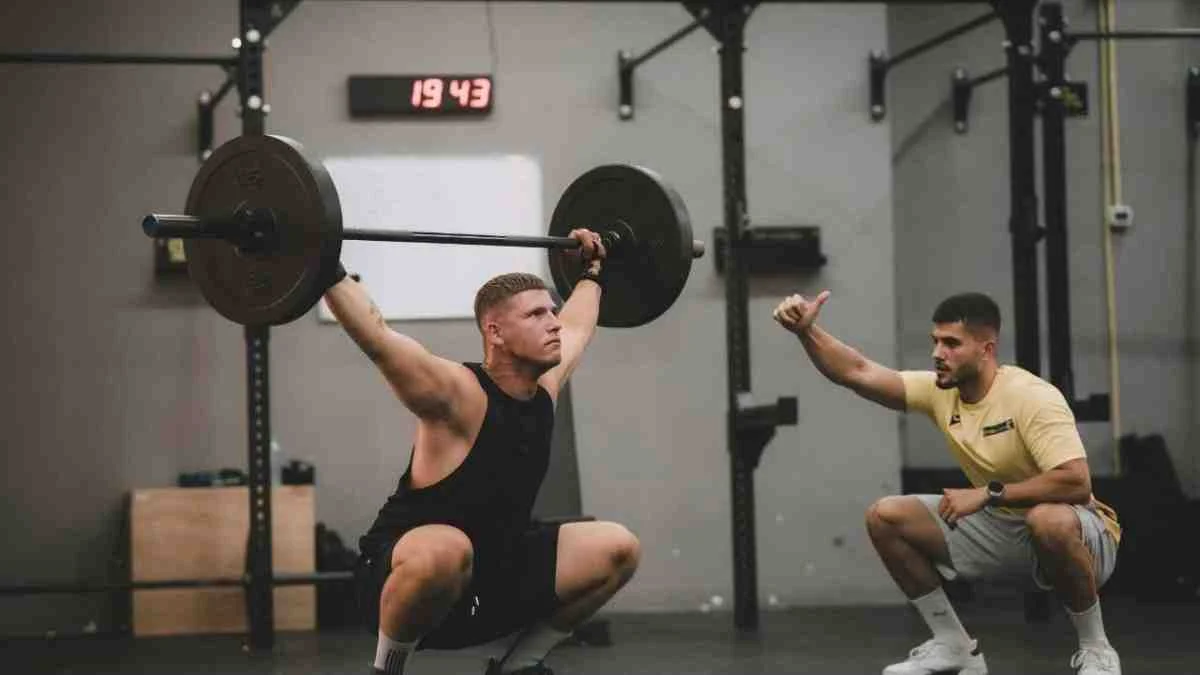[mashshare]
Many coaches might be aware of isoinertial training (horizontal) from the VersaPulley, which was introduced nearly 20 years ago. I was not aware of its popularity then, as I was training and not yet even considering coaching. More recently, the kBox helped put flywheel training back in the spotlight, and the systems from Sweden and Spain are huge here in the States.
Only use the #kPulley for an exercise after an athlete has mastered the traditional movement, says @ShaneDavs. Share on XAt Exceed Sports Performance, we got our hands on a kPulley in the middle of the 2018 summer off-season, and after a few days it became a part of our training. Since we already had a kBox at our disposal and an idea of what we liked and disliked, we decided to whittle down a list of exercises to the ones that made the most sense and wasn’t just about adding isoinertial training to an exercise better suited for conventional barbells and dumbbells. Creating the list was a hard process, because choosing your favorites and what may be best for others isn’t an easy task. This piece covers my five top exercises, with ways to do them better and how to determine when athletes are ready to perform them.
How I Created the List
I briefly touched upon flywheel exercises in a couple of previous articles, but kept the information pretty basic and straightforward. This piece will outline a few less-obvious choices and some potential options with which we are currently experimenting. We are lucky enough to have some research-grade sports tech at hand and will use it more to determine the efficacy of these movements. For now, the movements have passed the look and feel tests and have taken up a useful spot in our programming. We don’t typically just throw in some flywheel exercises, as that would be fairly lazy in my opinion, but we aim to replace or alter movements because of a specific need, and the kPulley and other flywheel tools create a unique opportunity for us.
All of the exercises can be done using traditional cables and elastic bands if needed, but the training effect won’t be the same. Four of the five movements require the athlete to aggressively overload the eccentric portion with an inflated concentric force, while the fifth (shoulder) should be strict during the entire exercise. As always, I would encourage any coach to come up with their own list based on experience, clientele, and specific needs, but we are sure there is value in the movements I list here.

Single Arm Eccentric Cheat Rows
Although it will seem like there are only two lower body exercises on this list (the rest being spine and shoulder training or rehabilitation options), almost all of them incorporate the lower body to create the necessary force to make them worth doing. What really makes the kPulley special is its use in horizontal pulling exercises that triple as oblique and adductor training as well. Although an athlete can do a simple row, and that is likely valuable for some of them, we much prefer the flywheel cheat row.
You can use a #kPulley in horizontal pulling exercises that triple as oblique and adductor training, says @ShaneDavs. Share on XThis exercise is great because it gives purpose to a movement that many athletes are already trying to do. How many times have we seen athletes do dumbbell rows with a little too much weight and somewhat “clean” the weight up? Plenty. Now we have a reason to let them cheat, assuming they know what an honest row should look and feel like. I believe this movement is actually much more of an anti-rotation/rotational core movement than just a simple row, and what makes this exercise special is that gravity isn’t limiting the technique and loading. “Cheating” can be taken to the next level and the forces acting upon the body are atypical of traditional weight training exercises.
Video 1. The amount of cheating can range from small assistance to total body exploitation of momentum creation. Coaches can experiment with how strict the eccentric portion of the lift is.
When an athlete performs the movement, they should use leg drive and a little bit of rotation to create the momentum and accelerate the handle concentrically. Then, they should control eccentrically using the lats, muscle groups surrounding the shoulder, obliques, and everything connected to the floor. Partial squat, half-kneeling, split stance, or any other method of ground contact will work, provided you can use the leg drive effectively. Most of the time, the exercise grooves into a pattern that is both safe and effective as a row and an anti-rotation pattern.

Rotational Chops with Triceps Ropes
The issue with most rotational movements is the lack of eccentric balance. Although the follow-through of rotational throws with medicine balls does have incidental eccentric contractions, the overload isn’t as high as you can create with flywheel training. In order to get a real bang for your buck, you need to cheat with skill and athleticism. Compensation cheating or fatigue-style degradation in technique is bad news, but a coordinated intentional cheat is what we are looking for with rotational chops.
Video 2. The goal with chops is to drive the force from the legs, so the receiving phase of the exercise is more demanding than traditional movements. The trunk is an excellent joint system to transfer force, but think ground up.
Receiving a true eccentric overload means athletes must create concentric momentum with a technique that uses the entire body. With most of the exercises listed, we want athletes to use a different technique to create momentum and a strict technique to receive the eccentric forces. If you’ve done your homework on baseball players or any rotational athlete, you’ll fully understand that forces are created from the bottom up. The ground is important and footing is paramount. If you need to add a wedge or a foot bar to create the force, go for it. The initiation of the exercise does start with a leg drive, but concentrically it finishes with a swing, so the athlete can be immediately ready to receive the forces in the proper body position.
Forces are created from the bottom up: The ground is important and footing is paramount, says @ShaneDavs. Share on XRopes are great attachments for rotational work. We use triceps ropes and prefer a single arm attachment using an overhand grip. We instruct the athlete to keep their hands close to them during the concentric phase of the movement and (usually) let the hands drift away during the eccentric portion. Similar to a Pallof press, the exercise has more torque as the hands extend farther away.
Once you gain efficiency in the strict chop, you can add a step or rotation during the concentric phase. You can step forward and to the side with the concentric phase as a conservative progression or alternative. Whether you stick with a strict movement or utilize the step, the chop is a great tool for tackling heavy eccentric force to the obliques and groin.

Eccentric Overload Hamstring Curl
We employ a lot of hamstring equipment at our facility, and most have a specific function and use. The same goes for the kPulley’s involvement in our hamstring work. I need to make the point that one exercise is never a cure-all or silver bullet for hamstrings. If you read the research, hamstring training seemed to be all about EMG years ago; now it’s about lengthening and eccentrically preparing hamstrings for sport. Don’t follow the leader: Diversify your program and train hip extension, knee flexion, and both simultaneously to ensure you cover the bases. As I mentioned before, we use flywheels to improve upon or replace a movement when it creates a better alternative than traditional options.
Video 3. Coaches should start off with the two legs up and two legs down before moving to two legs concentric and one leg eccentric. The rolling devices today are available from a few equipment manufacturers.
A popular technique in flywheel training is the “two-up and one-down” concept that most coaches are familiar with. Before isoinertial training became popular again, veteran coaches used two legs to lift the weight up before lowering the weight down with one leg when performing hamstring curls and RDLs. As with the row and chops listed above, adding technique variation to the concentric portion of the lift to overload the eccentric portion is just as valuable and effective as the two-to-one method, and the kPulley and kBox are perfectly set up for such.
I use #flywheels to improve or replace a movement when it’s a better choice than traditional options, says @ShaneDavs. Share on XI believe there are five major exercises (and a few variations of each) for the hamstring using the kPulley that are effective, and each has a different setup and function. For this piece, I focus on the supine bridge hamstring curl, as it’s one of the most popular methods for training hip extension (statically) and knee flexion (dynamically) in rehab or training settings. There are much better options for training true hip extension, but the supine bridge hamstring curl plays an important role in our training program and is worth exploring a bit. Supine bridge curls do have eccentric benefits, but lack a true closed chain quality, so we consider them a high-priority assistance exercise rather than a main option for performance.
Whether you use a slideboard (towel, slide disc) or a wheeled implement, there are four ways to train the bridged hamstring curl. No bridge, bridge after concentric, bridge during eccentric and concentric, and two-to-one lowering. As for the topic of eccentric overload, the concentric (no bridge) to eccentric (with bridge) is our method of choice, and if you try it I’m sure you’ll agree.

Shoulder Reconditioning with Eccentric Forces
Narrowing down all the shoulder-specific exercises to just one option or movement isn’t very fair, so it’s easy to get upset that I didn’t pick external rotations or another arm care flavor of the week. The shoulder is an interesting joint in the PT world, and every year sees a change as to the best exercises for preparing the overhead athlete for sport and reducing injuries. By the time this article is posted online, I’m sure the best practice with shoulder rehabilitation and training will have changed again. Yesterday’s rotator cuff exercise will fade into tomorrow’s scapular stability training and then to something else later. Just like the principles of good ACL prevention, good training will help keep the healthy prepared.
Video 4. The external rotation range of motion is based on skill and individual anatomy. Build the range of motion up carefully and gradually over time.
We don’t do much additional training to the shoulder, but we do know that the rotator cuff, even with a well-trained athlete, may not be fully maximized. There are dozens of exercises for the shoulder and arm, but the primary recommendation is that everything is performed strict and you only use the kPulley after an athlete has mastered the traditional movement.
We have a few movements that we tend to gravitate to the kPulley for, but the good old half-kneeling external rotation (ER) can be recognized by many and is still broadly accepted. The key here, as with the other exercises listed, is that you create a little more momentum/concentric force using a variation of the technique and then quickly get into the proper technique to control the eccentric portion. An added bonus of the flywheel ER movement is that the transition from a face pull or row to an ER involves a bit of dynamic stabilization, which most studies have shown to be more important than simply strengthening the cuff.
Prepare a program that utilizes appropriate methods—not just the methods that sell to the masses, says @ShaneDavs. Share on XAthletes with great corrective exercise routines and poor prime mover strength never succeed in sport. The opposite is often found in the training room or on the surgeon’s table. Be smart and prepare a program that utilizes appropriate methods—not just the methods that sell to the masses. Giving lots of funky exercises is like giving out full candy bars during Halloween—it may make you popular around the block, but it’s not the best practice for your nutrition program. Make sure your shoulder diet follows the same principles as your eating: well-rounded and balanced, with less junk.
My last recommendation with external rotation and scapular retraction exercises is to make sure you work with a very good sports medicine professional who is involved with football, javelin, and other throwing sports, not just baseball. Having a therapist who isn’t afraid to do anything overhead, while having the responsibility for throwing athletes such as quarterbacks and track athletes, has helped us tremendously. Sometimes it’s good to put aside the therapeutic bands and light dumbbells, and load the shoulder group with enough fortitude that it’s actually trained.

Knee Extension
Since I mentioned ACL prevention above, it’s worth noting that we deal with plenty of knee issues and “rehab” at our facility. An absurd number of young athletes start training with general knee pain or are training because of a major knee injury. We know that strength is lacking and that is usually where we start, but general strength is not quite specific enough. We have included a lot more quad strengthening, directly, in our programs and add in sequenced work for using the knee in almost all of our knee pain or injury cases.
We use the #kPulley the most for seated leg extensions and standing terminal knee extensions, says @ShaneDavs. Share on XThe two movements we use the most when it comes to the kPulley are seated leg extensions and standing terminal knee extensions (TKE). Both take some practice and setup manipulation, but the eccentric forces you can create using the pulley are invaluable. Specifically, the TKE movement: An athlete can use a little shift or body “English” to get the wheel spinning and then lock down the movement to control the flexion.
Video 5. Eventually, leg machines will grow in popularity, but for now a box works well. In the future, isometric and eccentric workouts will evolve to handle rehabilitation demands even better.
In almost every single “case” of general knee/patella pain we’ve come across, the affected leg has much less strength and control than the “good leg.” It’s probably a case of “chicken or the egg,” but we know that incorporating knee extension work directly before leg training has made a huge impact on our recovery times and long-term knee health success.
Video 6. It takes a while for coaches and athletes to get the handle of this exercise, but EMG biofeedback may help. Basically, the athlete is doing a reverse leg extension and uses the friction of the ground and momentum to challenge the quads.
Respect Momentum Before You Start
Most of the exercises listed use a little body English to overload the eccentric portion of the lift and, in doing so, require a little more focus and attention. There is an associated risk with any exercise that overloads a joint or body movement. With anything that will yield results, risk must be worth the reward.
Some exercises should be done one on one, while other exercises are fine to do without supervision at all when an athlete is highly trained and experienced. Other exercises are sure to be popular with the kPulley, but for our program, we know this list works well. Try each exercise and judge for yourself, as every facility and team training environment is unique enough to warrant you spending the time and thought to decide what is ideal for your situation.
Since you’re here…
…we have a small favor to ask. More people are reading SimpliFaster than ever, and each week we bring you compelling content from coaches, sport scientists, and physiotherapists who are devoted to building better athletes. Please take a moment to share the articles on social media, engage the authors with questions and comments below, and link to articles when appropriate if you have a blog or participate on forums of related topics. — SF
[mashshare]




